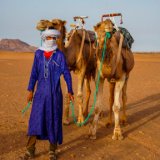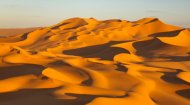|
Deserts in Africa |
Deserts in Africa |
Deserts in Africa |
Deserts in Africa |
|
|
List of Deserts in AfricaThe most significant challenge of living in African deserts is the extreme climate. Temperatures can soar above 50°C (122°F) during the day, while nighttime temperatures can plummet to below freezing in some areas. The lack of water and vegetation means that inhabitants must adapt to these harsh conditions to survive. One way desert dwellers cope with the heat is by constructing their homes from materials that provide natural insulation. For example, the Tuareg people of the Sahara Desert build homes called "earthen igloos" from mud bricks, which help to keep the interior cool during the day and warm at night. Similarly, the Himba people of the Namib Desert in Namibia use a mixture of clay and cow dung to create a protective layer on their homes, which helps to regulate the temperature inside. Water scarcity is another major challenge faced by desert dwellers. To overcome this, many communities have developed ingenious ways of collecting and storing water. For instance, the Zeriba people of the Sudanese desert build underground reservoirs called "zariba" to store rainwater, while the Maasai people of the Kenyan desert collect dew from plants and use it for drinking and cooking. In addition to these adaptations, desert-dwelling communities have developed unique cultural practices that help them cope with the harsh environment. For example, the San people of the Kalahari Desert in Botswana have a deep connection to the land and a profound understanding of the plants and animals that inhabit it. This knowledge allows them to find food and water sources that are not immediately apparent to outsiders. Despite the harsh conditions, African deserts are home to a diverse array of cultures and traditions. Each community has developed its own unique way of life, shaped by the environment and the resources available to them. For example, the Tuareg people of the Sahara Desert are known for their distinctive blue clothing, which is made from indigo-dyed cotton and helps to protect them from the sun's rays. They are also skilled traders, travelling long distances across the desert to exchange goods and ideas with other communities. The Himba people of the Namib Desert have a strong connection to their ancestral land and maintain many traditional practices, such as the use of red ochre to protect their skin from the sun and insects. They are also known for their intricate jewellery, which is made from materials found in the desert, such as ostrich eggshells and iron. The Maasai people of the Kenyan desert are renowned for their warrior culture and elaborate beadwork. They also have a deep respect for nature and believe that all living things have a spirit that should be honored and protected. Despite the challenges of living in African deserts, many communities have developed sustainable economic activities that allow them to thrive in their environment. For example, the Tuareg people have a long history of trading salt, which they extract from the desert's dry lake beds. Similarly, the Himba people rely on livestock farming, using their knowledge of the desert's plants and water sources to support their herds. In recent years, ecotourism has also become an important source of income for many desert communities. By sharing their unique cultures and traditions with visitors, these communities can generate revenue while also preserving their way of life. However, it is essential to ensure that tourism is developed sustainably, so it does not disrupt the delicate balance of the desert ecosystem. Living in African deserts is a testament to the resilience and ingenuity of human beings. Despite the harsh climate and scarce resources, diverse communities have adapted to their environment and developed rich cultural traditions that continue to thrive today. As we face the challenges of climate change and environmental degradation, there is much we can learn from the desert dwellers of Africa, who have found ways to live in harmony with their environment for generations. By embracing their knowledge and wisdom, we can work together to create a more sustainable and equitable future for all. |













